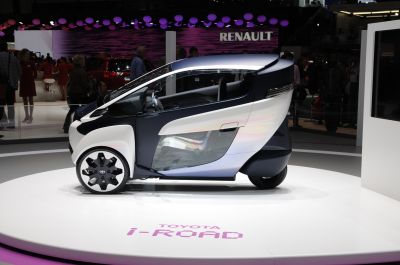Toyota i-Road

- Year: 2013
The Toyota i-Road is an innovative ultra-compact electric vehicle concept designed primarily for short-distance urban commuting. Unveiled at the 2013 Geneva Motor Show, it features a unique three-wheel design with two front wheels and one rear wheel, combining the agility of a motorcycle with the comfort and weather protection of a car. The vehicle seats two passengers in tandem within a fully enclosed cabin, allowing them to travel without helmets and remain shielded from weather and road noise throughout the year.
Measuring just 2,350 mm in length, 850 mm in width, and 1,445 mm in height, the i-Road's narrow profile allows it to maneuver easily through congested city traffic and occupy only a fraction of a conventional parking space. It employs an advanced automatic active-lean system that dynamically tilts the vehicle during turns to maintain stability and provide a smooth, exhilarating ride distinct from traditional cars or motorcycles. This system uses sensors and an ECU to adjust the lean angle based on steering input and speed, enhancing safety and handling.
Powered by dual 2 kW electric motors in the front wheels and a lithium-ion battery, the i-Road offers a quiet, zero-emission driving experience. It has a top speed of around 45 km/h (about 28 mph) and a driving range of approximately 50 kilometers (30 miles) on a single charge, making it ideal for short urban trips. The battery can be recharged fully in about three hours from a standard household power supply.
Toyota envisions the i-Road as a new category of personal mobility vehicle that addresses urban challenges such as traffic congestion, limited parking, and environmental concerns. While its compact size and electric powertrain offer clear benefits for city dwellers, its limited speed and range currently restrict its practicality for longer commutes or highway use. Nonetheless, Toyota continues research and development to refine the concept and explore its potential for future urban transportation solutions